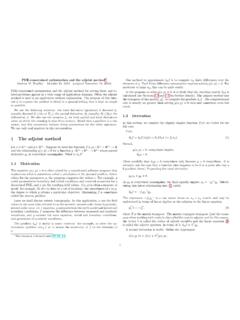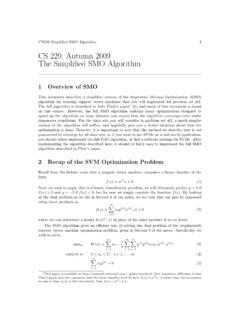Transcription of Constrained Optimization: Kuhn-Tucker conditions
1 Constrained optimization : Kuhn-Tucker conditions Brian Wallace, Economics dept September 23, 2004. Abstract In this document, we set out the Constrained optimisation with inequality constraints and state the Kuhn-Tucker necessary conditions for a solution; after an example , we state the kuhn - tucker sufficient conditions for a maximum. 1 The Problem Suppose we have a function f , which we wish to maximise, together with some constraints, gi ci , which must be satisfied. This leads us to the problem: g1 (x) c1. g2 (x) c2.. max f (x) subject to . gm (x) cm xi 0. We have seen how to solve this problem with equality constraints; we introduce a number of mul- tipliers 1 ,.. , m and form the Lagrangian which we partially differentiate with respect to each xi and each j and set equal to 0, to get a system of m + n equations with nm variables.
2 For the inequality case, we do a similar thing. First we form the Lagrangian, L: L = f (x) + 1 (c1 g1 (x)) + + m (cm gm (x)). Result 1 The Kuhn-Tucker conditions , which are necessary (but not sufficient) for a point to be a maximum are: L L. xi 0 xi 0 xi xi = 0 for all i = 1 .. n gj (x) cj j 0 j (c gj (x)) = 0 for all j = 1 .. m So, for each variable xi we have 3 conditions which must be met; similarly for each constraint (and hence ), we have 3 conditions which must be met. Each point that is a solution to this equation system is a possible candidate for the maximum. Once we have established all the points, we need 1. to check them individually to see which is the real maximum. The conditions are called the complementary slackness conditions .
3 This is because for each set of three conditions , either the first or the second condition can be slack ( not equal to zero), but the third condition ensures that they cannot both be non-zero. Notes: This is a maximum only problem. To do a minimisation, you need to maximise the function f (x). Secondly, notation in books varies, so some state the constrant conditions as gj (x) cj , in which case the signs of some of the terms in the Lagrangian are altered. example 1 max f (x1 , x2 ) = 4x1 + 3x2 subject to g(x1 , x2 ) = 2x1 + x2 10 and x1 , x2 0. We first form the Lagrangian: L = 4x1 + 3x2 + (10 2x1 x2 ). Hence, the necessary conditions for a point to be a maximum are: Lx1 = 4 2 0 x1 0 x1 (4 2 ) = 0. Lx2 = 3 0 x2 0 x2 (3 ) = 0.
4 2x1 + x2 10 0 0 (10 2x1 x2 ) = 0. We solve this set of inequalities and equations to find points which may be maxima. Let 1 (ii). denote the second condition on the first line etc. 1 (iii): x1 (4 2 ) = 0 x1 = 0 or = 2. Suppose = 2. Then: 2 (i): 3 0 1 0. which is clearly false. Hence, we must have that x1 = 0. Then: 2 (iii): x2 (3 ) = 0 x2 = 0 or = 3. We can see that, if x2 = 0 (together with x1 = 0): 3 (iii): 10 = 0 = 0. But this contradicts 1 (i). So, we have x1 = 0 and = 3. Hence: 3 (iii): 3(10 x2 ) = 0 x2 = 10. So, we have solved the system and found the only solution, which is x1 = 0, x2 = 10, = 3 and hence f (x1 , x2 ) = 30. As before with equality constraints, measures the increase in f (x1 , x2 ) for a one unit increase in the constraint ( increasing c1 = 10 by 1).
5 In general, solving such systems can be very tedious (although not difficult) if there are more than 4 variables and constraints in total. What you need to do is just plug away at every possible combi- nation and eliminate those that do not fit the conditions . When you have eliminated all impossible points, you will be left with a few candidate points which you must then check by substitution into 2. f (x) to find whether they are the maximum. For certain types of systems, we can assume the point(s) we find are maxima. This occurs if the function f and the functions gi satisfy some more conditions , known as the Kuhn-Tucker sufficiency conditions . Result 2 If the following conditions are satisfied: 1. f (x) is differentiable and concave in the nonnegative orthant 2.
6 Each constraint function gi (x) is differentiable and convex in the nonnegative orthant 3. a point x0 satisfies the Kuhn-Tucker conditions then the point x0 is a maximum. [The nonnegative orthant is the region where each xi 0]. example 2 Suppose f (x, y) = 2x + 3y and g(x, y) = x2 + y 2 2. Show that f and g satisfy the Kuhn-Tucker sufficiency conditions and hence find the maxima of f (x, y). Well, all linear functions are both convex and concave, so f is certainly concave, and is clearly differentiable. As for g(x, y): we can show g is convex by showing the differential d2 g is positive definite. The Hessian matrix associated with g is: " #. 2 0. H=. 0 2. So clearly |H1 |, |H2 | > 0, so g is convex. Hence, any candidate points we find will automatically be maxima.
7 As before, we form the Lagrangian: L = 2x + 3y + (2 x2 y 2 ). The Kuhn-Tucker conditions imply that: (1) Lx = 2 2 x 0 x 0 x(2 2 x) = 0. (2) Ly = 3 2 y 0 y 0 y(3 2 y) = 0. (3) x2 + y 2 2 0 (2 x2 y 2 ) = 0. 1 (iii) implies that either x = 0 or x = 1. If x = 0, then 1 (i) cannot be satisfied, hence x = 1. Similarly, y = 23 from 2 (iii) (and clearly x, y, > 0). Substituting these values for x and y in 3. (iii), and noting that > 0, we get: 2 2 r 1 2 13.. 2 2. 2 x y =0 2 =0 = . 3 18. q q q 13 8 18. As > 0, we must have = 18 , hence y = 13 and x = 13 , and we have a maximum at this point. 3.






